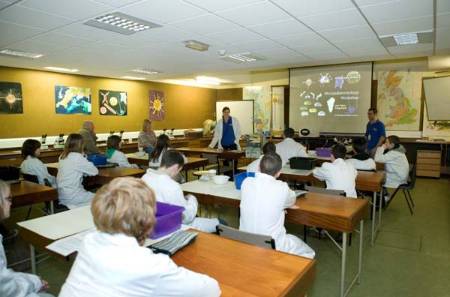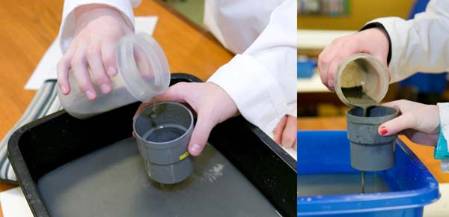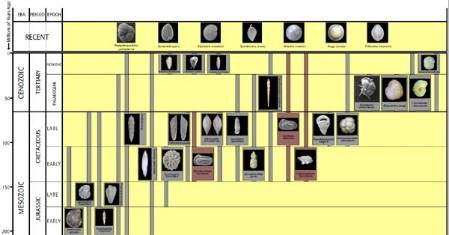A few weeks ago the Center for the Future of Museums blogged on how to get your museum blog widely read, sadly stating that writing for a niche audience like micropalaeontology is unlikely to be successful. As a reply I thought I would share my own experiences on what has worked for me and what hasn't, with nine tips for museum bloggers.
Choose an eye-catching title and subject
The title and subject ultimately convince the reader whether to visit your post or not. I agree with the Center for the Future of Museums that blogs with titles and subjects that are of general interest will be more widely read, as the post asking Do we need specialist curators? has shown. However, it is also possible to write about your specialist collection and make it relevant to a general audience, such as What microfossils tell us about early humans in Britain or When microfossils meet dinosaurs. Other more specific posts describing collections, databasing or risk management have not been so well read.
Utilise social media to advertise
I quickly realised that there was no point in posting and just hoping that people will automatically find what you have written. Posts tweeted by @NHM_London, which currently has over 400,000 followers, receive significantly more hits than others. We started the @NHM_Micropalaeo Twitter feed to provide micropalaeontology news from the Museum and to advertise posts from this blog. Other relevant advertisement vehicles have been sites such as Facebook, Reddit or LinkedIn, while #AskACurator day on twitter was also a great opportunity to publicise our collections by highlighting previously published blog posts.
Build links with other bloggers and webmasters
Link regularly to associated websites and write to the site owners to let them know that you have done so. I link regularly to the Geological Curators' Group, Forams.eu and The Micropalaeontological Society and they have all provided reciprocal links. Other sites such the Museum website, Focus Magazine and blogger Tony Edger have provided links to my writing, prolonging the reading life for some posts way beyond the point when they are not visible on the blog front page.
Link to other sites clearly
The visibility of your blog to search engines such as Google is significantly enhanced if you link via a string of text that describes the link. For example, it is best to link to The Micropalaeontological Society rather than writing 'click here'.
Run your own email distribution list
Most sites, like this one, have the option to subscribe and receive updates when new posts go live. This works reasonably well if a lot of people make the effort to create an account and log on to follow your posts. However, most readers I have spoken to do not do this. I have lost count how many times I have heard people say 'I like your blog but I haven't looked at it recently'. I have set up a mailing list based on people I regularly deal with and send a message out every time I post a new blog. Posting blog links to relevant academic listservers has also been successful in generating additional readers.
Write for an audience
I write all posts as if I am explaining to my mother or mother-in-law, but at the same time making the post interesting to experts in the field of micropalaeontology wanting the latest news from the Museum. I feel confident that I am reaching my target audiences as I have been pleased to receive feedback from a wide range of readers, including:
- university academics
- students
- school teachers
- amateur micropalaeontologists
- members of the public
Think carefully about your reasons for blogging
In my first post I gave the following reason for starting this blog:
In this age of austerity, I believe that we should be highlighting the good news coming from the Museum so that the applications and relevance of our collections, including those from micropaleontology, are brought to people’s attention.
Even when writing more general posts like this one, I have this theme in my head while writing so it is always possible to include information about our collections and their relevance.
Get your timing right
There is no point in publishing a Microfossil Christmas card blog piece on Christmas Eve and hoping that lots of people will be logging on to read it. Similarly if you are going to tweet about your latest post it is best to do it at at time when most people are likely to read it. My successful post on How to become a curator? was timed to coincide with half term and a gallery exercise called 'curious curators'. Another post went live to coincide with the opening of our Treasures Gallery at the Museum.
Include a good balance of personal narrative
How much you write about yourself and your feelings depends on your writing style and subject of your blog. My blog highlights the collections and their use and not myself, so I sometimes feel that I do not include enough of my own personal story. Posts where I have shown how passionate I am about collections and collecting like my post on 'How to become a curator have been well received though.
Post regularly
If you don't get overnight success then don't give up. It takes time to gain a following, build relationships with other bloggers, webmasters or fellow Tweeters. By definition the more often you post, the more hits you'll get. People are more likely to follow or keep checking a blog that is active.
It has been hard work but as a curator I feel that blogging about my collections has had a major impact on their profile and I would encourage any curator to do the same. In summary, if you write interesting material that gets tweeted and retweeted around the internet then people will read it, whether you are writing about 'niche collections' or not.







